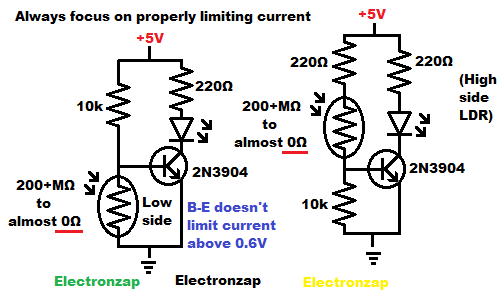Table of Contents
Light Dependent Resistors (LDRs) can easily alter the voltage and current that switches NPN Bipolar Junction Transistor (BJTs). That makes it so that light level determines whether the transistor, and it’s load, are on or off.

This diagram looks at 2 ways that use a light dependent resistor (LDR) and fixed resistor voltage divider that switches an NPN BJT on or off depending on light level.
Here is a affiliate link ad to a LDR (photoresistor) kit that I bought and use in my videos.
LDR on high side base voltage divider:
When the LDR is on the high side of the voltage divider controlling a NPN BJT, then the voltage at the base goes up when there is more light falling on the LDR. Once the voltage rises up to about 0.6V, current flows through the base, which turns the NPN BJT and LED on.
- LED off when it is dark.
- LED on when it is bright enough.
Note: You should use a minimum value fixed resistor in series with the LDR when it is on the high side of a voltage divider headed to an NPN BJT base. That’s even if you don’t see it in the schematic of a circuit you are looking at. The LDR will get close to 0Ω of resistance under bright light, which means that almost nothing limits current through it and the transistor base without some extra series resistance.
LDR on low side of base voltage divider:
When it is dark, the LDR will have very high resistance. Virtually no current will flow through it, so that current flows from the positive supply, through the resistor and the NPN BJT base. The NPN BJT and LED are on. The LED is lit.
- LED on when it is dark.
- LED off when there’s enough light.
Light falling on the LDR gives a relatively good connection (low resistance) to ground. That quickly pulls down the base voltage below 0.6V because it’s easier to flow to ground than through the base to emitter. No base to emitter current, means that there can be no collector current. The NPN BJT and LED are off. The LED does not light up.
To support this site, check out the following links:
- Check out my YouTube videos! https://www.youtube.com/c/Electronzap/videos
- Products I used in my videos or otherwise think look like a good buy. As an Amazon associate, I earn from qualifying purchases. https://www.amazon.com/shop/electronzapdotcom
- Information on this site is not guaranteed to be accurate. Always consult the manufacturer info/datasheet of parts you use. Research the proper safety precautions for everything you do.
- Electronzap is a participant in the Amazon Services LLC Associates Program, an affiliate advertising program designed to provide a means for sites to earn advertising fees by advertising and linking to amazon.com.